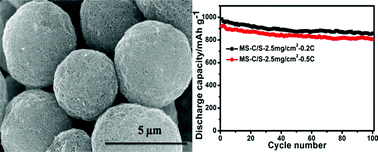MWCNT porous microspheres with an efficient 3D conductive network for high performance lithium–sulfur batteries†
Abstract
Lithium–sulfur (Li–S) batteries are considered as a promising commercial alternative to lithium-ion batteries (LIBs) for next-generation battery systems. However, the practical application of Li–S batteries is hindered by several obstacles, such as the insulating nature of elemental sulfur and the high solubility of lithium polysulfide products. In this work, a new type of multi-walled carbon nanotube (MWCNT) microsphere was synthesized successfully and used as a carbon framework for the sulfur cathode of lithium sulfur batteries. Commercial aqueous-dispersed MWCNTs of low cost are easily accessible for the large-scale production of the carbon skeleton through a simple spray drying approach. The as-prepared carbon framework shows a porous microspherical architecture with the particle size of around several micrometers, and the MWCNTs in it are intertwined to construct a three-dimensional (3D) continuous electronic conductive network. For the sulfur cathode, the C/S microspheres (MS-C/S) were facilely prepared by a melt-diffusion method. The obtained MS-C/S electrode displays excellent cycling stability and rate capability. The electrode with a sulfur loading of 2.5 mg cm−2 shows an initial discharge capacity of 983 mA h g−1 and a stable capacity of 858 mA h g−1 after 100 cycles at a current rate of 0.2C. Even when the current rate increases to 0.5C, a stable capacity of 806 mA h g−1 is maintained over 100 cycles.


 Please wait while we load your content...
Please wait while we load your content...